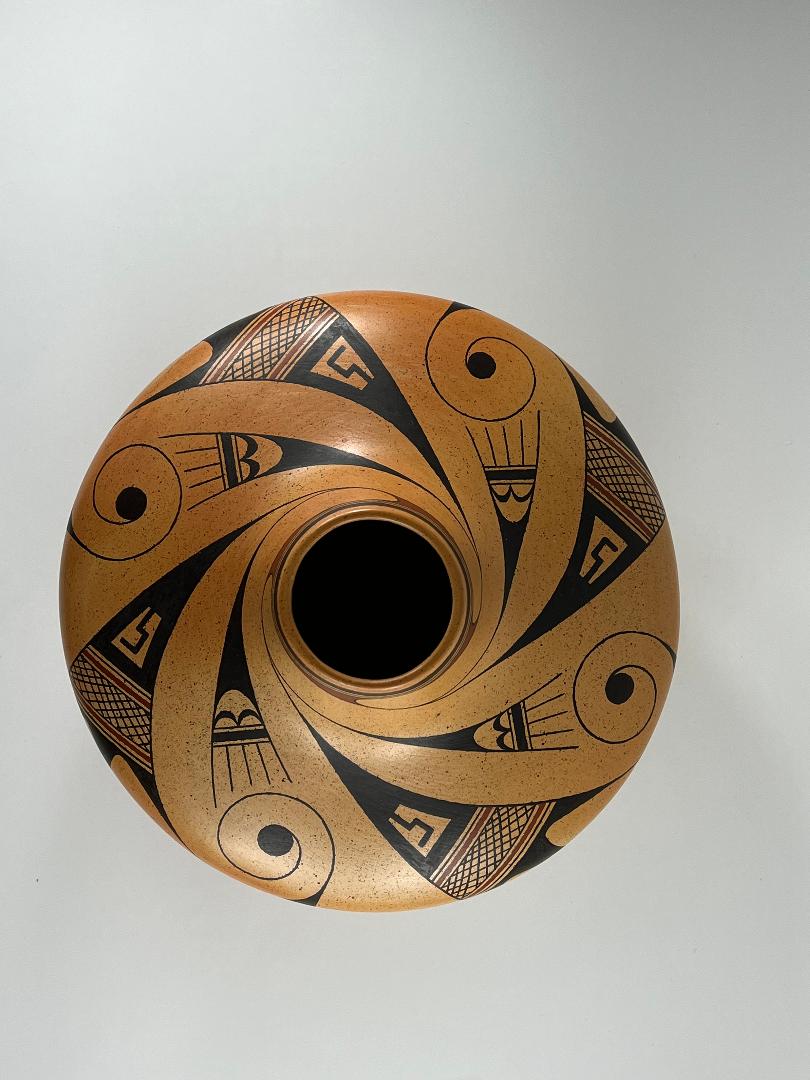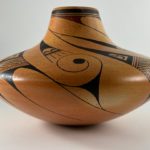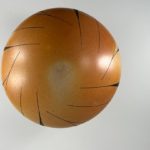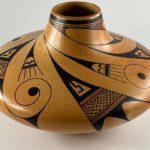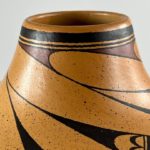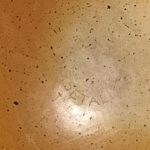Some Hopi pots are wonderful because of their shape and firing (1993-05, 1995-10 and 2022-02) and some excel because of their design (2014-07, 2014-15 and 2018-08), but this seedjar by Stetson Setella has both wonderful form and beautiful design. Rarely are the designs on Hopi or Hopi-Tewa pots narrative, but jar 2021-05 carries one of the most narrative designs of any pot in this collection. The form of the jar reinforces its design, and what is portrayed is the central, essential, blessing relationship of Hopi life.
Stetson was about 35 when he made pot 2021-05.
Form:
The jar has especially thin and even walls and is thus surprisingly light for its size. From a 0.75-inch base it curves outward 5-inches to its waist. The diameter of the jar is more than 11 times the diameter of that tiny base, yet the jar sits stable and level on a table top. The upper surface of the jar is 3.5-inches wide before it smoothly rises to form a 1.5-inch neck. The pot carries substantial blushing from its outdoor firing. The base is the palest area, while the rest of the bottom surface is a tan-orange. This deeper blushing carries over to about one-third of the top surface, the rest of the top being somewhat lighter.
Design:
On a saucer-shaped Hopi jar, the design usually has four distinct sections: neck, upper surface, waist and lower surface. The design on pot 2021-05 is particularly powerful because Stetson has painted a single pattern of design over the entire surface of the jar. While almost all of the design is on the neck and upper surface of the jar, Stetson did not use lower framing lines, so elements of the design continue onto the bottom surface of the pot to within 2-inches of the small base.
The jar is monochromatic, except for small red elements in two areas of the design. One of the distinctive features of Stetson’s pottery is the deep, dramatic color of his paints (cf 2010-15). The entire surface of the pot is covered with a thin sprinkling of tiny black dots. As was the Sikyatki tradition, thick-over-thin framing lines mark the design’s upper boundary.
Following an insightful suggestion made by Charles King (reprinted below) I identify the larger triangular figure as an abstracted bird and the smaller triangular figure as a rain cloud. A first look these two motifs seem distinct from each other: a smaller triangular shape positioned above a larger similar shape. These pairs are repeated four times around the circumference of the jar. That quick look, however, is misleading. First, near the neck of the jar the points of the two triangular shapes merge into a single line that continues upward to create a distinct pattern near the framing lines. The two forms are joined. Second, during that first look it appears that the smaller of these triangular shapes fans out to a circular motif with a large black ball at its center. However this circular element is actually an extension of the avian form that swirls up from below until it visually occupies space just behind the smaller triangular shape. Visually the two elements of design are entangled. Finally, at first glance the design seems composed of distinct elements. This too is in error. With the exception of the speckled surface and the framing lines, the design is of one piece. With a stylus a person could trace from any one point on the design to any other point on the design without crossing undecorated space. What is accurately captured by a glance is that every element in the design has a curved form and all elements swirl to the right.
While the design is thus a unified whole, I cannot analyze it without distinguishing its parts, so I will artificially segment it into three design motifs: 1) the avian form, 2) the rain cloud, and 3) the red upper-neck design.
The avian form:
This bird is represented by a large curved fan that widens as it moves away from the neck of the jar . It begins as a line on the neck and then forms 4-inch solid-black point. At its widest point is inset an unpainted area in the shape of a parallelogram . Emerging from the short side of the parallelogram onto the unpainted surface is a black question mark with 90-degree angles. At the blunt end of the black point is a series of three parallel lines that, with the edges of the surrounding elements, form a “four-lane highway.” The second lane is a thicker red line, sort of an esplanade in the street. Following is an inch-wide space with 11 lines drawn at an angle to 11 other lines, thus forming a tessellated pattern of diamond shapes. The lines are somewhat casually drawn so the size and pattern of lens shapes is somewhat irregular. The far edge of this this matrix abuts another four-lane highway, again incorporating a red line. This abstracted representation of a bird ends with a flair of three solid-black elongated triangular elements that share a thin base, each triangle quickly morphing to lines 2.25-inches, 3.5-inches and 5.0-inches long, in that order. When the pot is viewed from the bottom, these ranked curved lines, one set from each of the four repetitions of the design, are the only visible decoration, aside from the light splatter of dots.
The longest of this set of three lines carries an additional design element. About an inch from the start of this line Stetson drew an arched line that smoothly ascends and then reconnect with the line, giving this normal curve a base of about two inches. This arch is the lower edge of an inch-tall solid black triangle. At the point of the triangle the sides converge to form a thin 5.5-inch long line. This line becomes a 1.5-inch diameter curlicue, ending in a large black dot. Ascending off the avian form, this curlicue is positioned directly behind the rain cloud.
The rain cloud:
This small triangular form also begins as a line on the neck and then widens to a 2.75-inch long solid black point. An unpainted dome-shaped space defines the wide end, like a notched arrow head. Intruding into this space are two curved shapes joined at their points, like the silhouette of a stylized bird. Following is a three-lane “highway,” but here the narrow outer lanes flank a thick black central lane. Growing out of the highway are 5 thin lines, flared slightly. Just off the tip of these lines is the curlicue emerging from the avian form below.
The red upper-neck design:
These four red elongated triangles are outlined with a thin black line and, except for the two bars in the large wings, are the only red elements on the jar. They are arrowhead-shaped with a circular notch in the base and encircle the neck of the jar. These elements are not discrete: the point of the arrow to the right elongates into a line that joins the upper point of the base of the arrow to its left. Meanwhile, the black lines that outline the lower point of the base join and continue downward as a single line that becomes the origin of the two triangular elements below.
Design analysis:
Every aspect of pot 2021-05 contributes to a sense of lightness, energy and transformation.
Thin walls provide a tactile sense of lightness. Rising from its tiny base and spreading outward, the jar seems to float off a table on which it is placed. The upper surface transitions smoothly into the jar’s neck, adding to the jar’s upward thrust.
All the elements of design have a marked circular motion to the right. The design flows. Lines spread out to become triangles; triangles narrow and reform into lines. Visual energy is created when wide black elements are paired with thin lines and linear forms are juxtaposed with curlicues. The design on jar 2021-05 is very carefully drawn, except for the tessellated pattern in the large wing. The irregularity of this pattern interrupts the perfection of the painting and further adds energy to the design. Nampeyo frequently added a small detail that threw her designs off balance to create the same effect.
Several techniques provide unity amid all this motion. The black arrowhead at the base of rain cloud is the same form as the red arrowheads immediately above it. A very modest —almost subliminal— use of color links elements of design together. The gentile pattern of black dots that cover the surface of the pot provide a context which unifies the overall pattern of design. Of course the fact that there is a unity of line in the design –every point on the design is connected to every other point— is also visually unifying. These patterns seem to have meaning.
Iconography:
I purchased this jar from Charles King. In his provenance (reprinted below) he identifies the small wing shape as a rain cloud, the large form as a bird. It follows that the abstracted iconography of the jar portrays the central Hopi understanding of blessing.
Prayers and rain are connected, as are the two triangular elements of design on this jar. Birds and their feathers carry the prayers of the people upward to the Gods. If accepted, the prayers result in rain: here the clouds sprinkling black dots of rain. Wind, accompanies rain. Large curlicues of wind emerge from the avian prayers and interact with the rain clouds above. As detailed above, all elements of the design are interconnected, as is the behavior of people and the response from the heavens: a reciprocity of blessings.
The absence of lower framing lines, and resulting unbounded layout of the design, is central to the meaning carried by the pot. Since the exchange of prayers for rain and wind occurs in the heavens, one might say (both figuratively and literally) that the upper surface of the jar is heavenly while the bottom of this jar represents the experience of living in the Fourth World desert of the Hopi. Wisps of the people’s prayers carried by prayer feathers can be seen from below, but mostly the rain that is the Gods’ response fills this space where people live.
The light weight and form of the pot reinforces the message carried on its surface. The lightness and expansive upward shape of the jar carry the design upward.
Provenance:
Jar 2021-05 was purchased from King Galleries, Scottsdale, and came with the following description, provenance and photograph:
“This jar has great provenance. In 1997 I was at Jerry Jacka’s house when he was photographing some pottery for his book, Art of the Hopi which was published in 1998. He was photographing work by Dee Setalla and Stetson Setalla for the book. He had them wait so I could meet them and ended up buying their pieces that were featured in the book. Amazingly, this jar has come back to the gallery after all these years! It is featured in a two-page photo spread in the book….The jar has a wide shoulder and an elongated neck. It is fully painted with swirling birds extending from the rim to the shoulder. Separating the birds are swirling rain clouds. The jar was traditionally fired to create the blushes on the surface. It is signed on the bottom with his name “S. Setalla” and a raincloud. It is in excellent condition with no chips, cracks, restoration, or repair.”
“The Art of the Hopi” photograph, with jar 2021-05 at the center.
Jar 2020-05 is beautiful: its weight form, and design in perfect harmony. All aspects of the jar communicate the reciprocity of blessings: a symphony. It also brings the essential relationship of the Hopi people with the Gods into my home. Another blessing.

